A Simple Guide to the Chemex Ottomatic
Making coffee often feels like a choice between quality and convenience. You can do a manual pour-over, which gives you great tasting coffee but takes time and effort. The famous Chemex is a great example of this.

The manual process can be tricky and slow. The Chemex Ottomatic tries to solve this problem. It promises the same great coffee as a manual Chemex, but with the press of a button.
This guide will walk you through everything you need to know about this machine. We'll cover setup, tips, and the materials it's made from. You'll learn if this coffee maker is the right fit for you.
How the Chemex Ottomatic Works
The Chemex Ottomatic isn't like a normal coffee pot. It's a machine designed to automatically make pour-over coffee. It copies the steps a person would take to make a manual Chemex brew.
The machine controls all the important parts of brewing. It heats water to the perfect temperature for making good coffee. It also does a "bloom" step, which is a quick pre-soak of the grounds to get them ready.
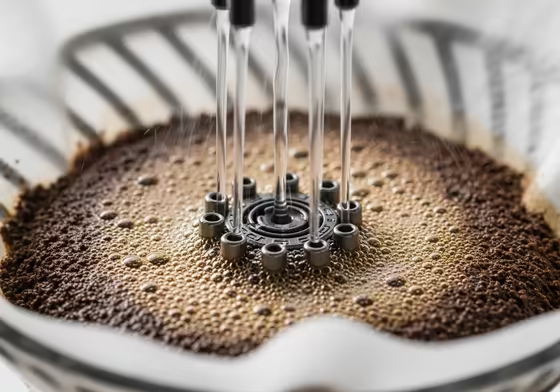
The machine uses a special sprayhead that pulses water over the coffee grounds. This makes sure all the grounds get wet evenly for a better taste. It also has a hot plate to keep your coffee warm for 90 minutes without burning it.
What's New in the Ottomatic 2.0?
The main new thing in the Ottomatic 2.0 is an "Iced Coffee Mode." This setting makes a stronger, more concentrated coffee. It's designed so it won't taste watery when you pour it over ice.
People really like the modern look of the 2.0 model, and it matches the Chemex glass pot perfectly. But two things often come up as downsides. The machine is expensive at around $350, and many people are disappointed by how much plastic it has.
The Missing SCA Certification
For expensive coffee makers, a certification from the Specialty Coffee Association (SCA) is a big deal. It's an independent seal of approval that proves the machine meets high standards for brewing. This helps you know you're getting a quality product.
Some websites say the Chemex Ottomatic is SCA Certified, but this seems to be wrong. When you check the official SCA list, the Ottomatic isn't on it. This is a pretty big deal for a machine this expensive.
Its main competitors, like the Technivorm Moccamaster and the Ratio Six, are both SCA Certified. This means while the Ottomatic claims to work well, it doesn't have the official proof that its competitors do. You're paying for the design, not for a third-party tested performance.
How to Use the Machine
The machine is simple to operate with just one switch. A solid red light means it's brewing. A solid white light means the hot plate is on, and a blinking white light means the hot plate turned off.
The Ottomatic works with most Chemex pots (3, 5, 6, and 8 cup sizes). But it does not work with the larger handblown models. So make sure you have the right kind of pot.
The machine has a 1-year limited warranty. It's important to know that if you don't clean and descale it correctly, you could void the warranty.
Getting Started
How Much Coffee Should You Use?
This is the most important setting you can control. The manual gives a measurement in tablespoons, but you should ignore that. Using a weight scale is much more accurate and will give you better coffee.
- The Official Ratio: The manual suggests a 1:16 ratio. This means for every 1 gram of coffee, you use 16 grams (or ml) of water. This is a great starting point.
- The Expert Range: Most coffee experts use a ratio between 1:15 and 1:17. For a standard 6-cup Chemex, you would start with about 55 grams of coffee. You can then adjust it to your taste.
- A Pro Tip: Chemex filters are very thick, which can let water flow through quickly. Some people use a stronger ratio, like 1:14, to get a richer cup of coffee.
You also need the right coffee grind. For the Ottomatic, you'll need a medium-coarse grind. It should look coarser than drip coffee but finer than what you'd use for a French press.
Here's a simple chart to help you get started.
Table 1: Coffee and Water Ratios
| Desired Yield | "Cup" Size | Water (to fill line) | Coffee (1:16 Ratio) | Coffee (1:15 Ratio) | Grind Size |
|---|---|---|---|---|---|
| 15 oz | 3-Cup | ~440 mL | 27.5 g | 29 g | Medium-Coarse |
| 30 oz | 6-Cup | ~880 mL | 55 g | 58.5 g | Medium-Coarse |
| 40 oz | 8-Cup | ~1180 mL (Max) | 74 g | 78.5 g | Medium-Coarse |
Note: Start with the 1:16 ratio. Use a 1:15 ratio for a stronger cup or a 1:17 ratio for a milder cup.
How to Clean the Chemex Ottomatic
Keeping the machine clean is important for good flavor and a long life.
- Basic Cleaning: The glass pot can go in the dishwasher if you take the wood collar off. You can wipe down the machine with a damp cloth.
-
Regular Descaling (Very Important):
You have to descale the machine to remove mineral buildup from water. If you don't, it could stop working well and even void your warranty.
- How often: Chemex suggests doing this every 40 brews, or at least every three months.
- How to do it: Use a descaling solution. Fill the water tank, add the solution, and run a full cycle with no coffee in it. After that, run at least two more cycles with just fresh water to rinse everything out.
Materials and Safety
When you pay a lot for a coffee maker, you want to know what it's made of. Many people look for a machine that is free of plastic.
Does the Chemex Ottomatic have plastic?
Yes, it does. While the machine looks like it's mostly metal and glass, it is not a plastic-free coffee maker. This is a common complaint from people who buy it, especially since it costs $350.
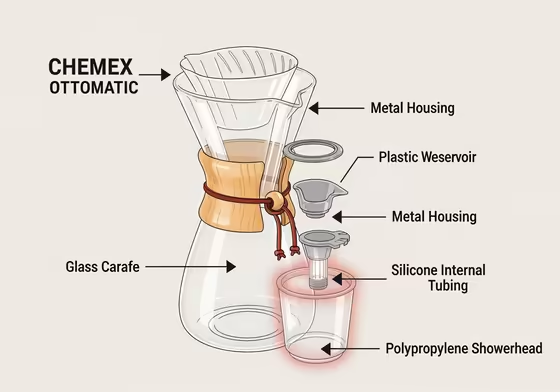
Where is the plastic?
Here is a breakdown of what the machine is made of:
- Glass: The coffee pot is made of glass.
- Metal: The outside of the machine, the hot plate, and the internal water boiler are metal.
- Plastic (Cold Water): The water tank where you pour cold water is plastic.
-
Plastic (Hot Water):
This is the part people worry about most.
- The internal tubes that carry hot water are Silicone.
- The showerhead that sprays hot water on the coffee is Polypropylene (PP).
Is the plastic safe?
The company says the machine is not plastic-free, but that the plastics used are "food safe" and BPA-free. This means they don't have certain chemicals people worry about.
Still, there is a growing concern about microplastics. BPA-free does not mean it is plastic-free. The Ottomatic sends very hot water through plastic tubes and a plastic sprayhead.
This process is known to release tiny plastic particles called microplastics. We will talk more about this health concern later in the guide.
How it Compares to Other Coffee Makers
A $350 coffee maker has a lot of competition. The Ottomatic is often compared to other popular machines in the same price range.
Chemex Ottomatic vs. Moccamaster
The biggest competitor for the Ottomatic is the Technivorm Moccamaster. Both cost about the same and are aimed at people who want great coffee at home.
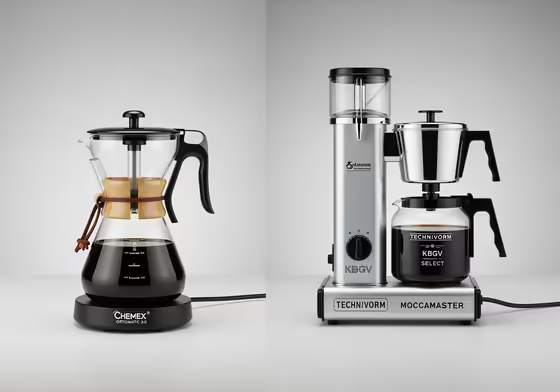
- Similarities: Both machines cost around $350. They both promise to brew coffee to very high standards. And both use a mix of metal and plastic parts.
-
Key Differences:
There are some important differences between them.
- SCA Certification: The Moccamaster is officially SCA Certified, while the Ottomatic is not. This gives the Moccamaster an edge in proven quality.
- Brew Style: The Ottomatic is designed to do just one thing: make coffee with a Chemex filter. The Moccamaster is a more traditional high-end drip coffee maker.
- Reputation: The Moccamaster is known for being extremely durable and easy to repair, often lasting for decades. The Ottomatic has more mixed reviews, with some users reporting problems.
The choice between them is pretty clear. If you want proven performance and a machine that will last a long time, the Moccamaster is the safer bet. If you love the Chemex look and the specific taste of its coffee, the Ottomatic is the only machine that automates it.
Is there a good alternative with no plastic?
If you are worried about the plastic parts in both the Ottomatic and the Moccamaster, there is another option. The Ratio Six and Ratio Eight coffee makers are good alternatives.
The Ratio machines are known for using better materials. They have glass water lines and a stainless steel shower head. This design makes sure that hot water touches as little plastic as possible.
Why do people like Chemex so much?
The reason people love the Chemex system isn't just the glass pot. It's the special paper filters that make the coffee taste so good.
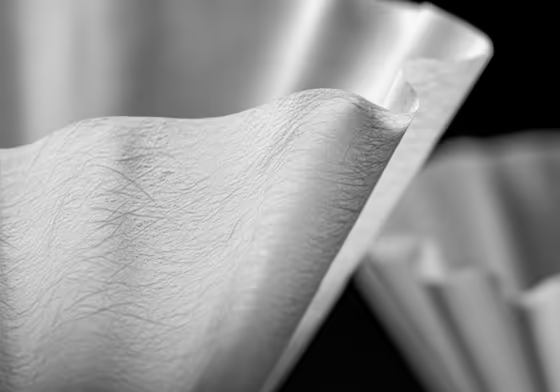
These filters are 20-30% thicker than other coffee filters. This thick paper traps more oils and small coffee grounds. The result is a very "clean" and "sweet" cup of coffee with less bitterness.
Is pour-over coffee better than drip?
- Pour-Over: Manual pour-over is better if you want complete control. You can adjust every step to get the perfect flavor from your beans.
- Drip: An automatic drip machine is better if you want convenience. It's fast and easy, but usually makes a more average cup of coffee.
- The Ottomatic: The Ottomatic tries to give you the best of both. It offers the quality of a pour-over with the convenience of an automatic machine.
Pros and Cons
What are the downsides of pour-over coffee?
The Chemex Ottomatic was made to solve the common problems of manual pour-over coffee.
- It takes time. Making pour-over by hand is a slow process that requires patience. Many people are too busy for that in the morning.
- You have to pay attention. You can't just press a button and walk away. You have to carefully pour the water in circles.
- It's easy to mess up. It takes practice to get it right. If your coffee tastes bitter or sour, you probably did something wrong. The Ottomatic automates this process to avoid these mistakes.
Table 2: How the Ottomatic Compares to Competitors
| Feature | Chemex Ottomatic 2.0 | Technivorm Moccamaster KBGV Select | Ratio Six |
|---|---|---|---|
| Approx. Price | ~$350 | ~$359 | ~$365 |
| SCA Certified | No (Not officially certified) | Yes (Meets "Golden Cup" standards) | Yes (Meets "Golden Cup" standards) |
| Hot Water Path | Plastic (Silicone tubes, plastic sprayhead) | Plastic (Plastic brew basket and reservoir) | Minimal Plastic (Glass lines, steel showerhead) |
| BPA-Free | Yes | Yes | Yes |
| Carafe Type | Glass (with 90-min hot plate) | Glass (with 100-min hot plate) or Thermal | Thermal (No hot plate) |
| Unique Feature | Automates the Chemex filter system. Has an Iced Coffee Mode. | Proven to be durable and repairable. | Minimalist design with very little plastic. |
| Best For... | Someone who loves the Chemex look and taste. | Someone who wants certified performance and durability. | Someone who wants minimal plastic contact. |
Making Coffee the Healthiest Way
People sometimes worry if their coffee is healthy. This concern usually comes down to two things. The first is the quality of the coffee beans, and the second is the equipment you use to brew it.
What is the healthiest way to make coffee?
To make the healthiest coffee, start with high-quality beans from a good roaster. This helps avoid toxins from mold that can grow on poorly stored beans.
Next, use a brewer made from safe materials like glass, ceramic, or stainless steel. These materials don't release chemicals into your coffee. The healthiest methods are manual ones where you have full control.
- Manual Pour-Over: Using an all-glass Chemex or an all-ceramic brewer.
- French Press: Using a model made of only glass and stainless steel.
- Moka Pot or Percolator: Using a stovetop model made of stainless steel.
Coffee made with a paper filter, like a Chemex, can also be healthier. The paper traps oily compounds that have been shown to raise cholesterol levels.
How can I avoid microplastics in my coffee?
The best way to avoid microplastics is to stop hot water from touching any plastic parts. This is a real risk. Many popular coffee makers, including the Ottomatic, use plastic parts that get hot.
The Ottomatic sends near-boiling water through a plastic sprayhead. A 2023 study showed that steeping a plastic-based coffee bag in hot water could release thousands of microplastic particles. This suggests that any coffee maker that uses hot plastic parts could be adding microplastics to your coffee.
What is the best non-toxic coffee maker?
If you want to avoid plastic, your best options are clear.
Table 3: The "Plastic-Free" Coffee Maker Guide
| Tier | Material Purity | Recommended Brewers | Why? |
|---|---|---|---|
| Tier 1: 100% Plastic-Free (Manual) | Best: Inert glass, ceramic, or stainless steel. | • Manual Chemex (Glass) • Hario V60 (Ceramic/Glass) • French Press (Glass/Steel) • Stovetop Percolator (Steel) | These methods guarantee zero microplastic from the brewer. |
| Tier 2: Almost Plastic-Free (Electric) | Excellent: Designed to keep plastic out of the hot water path. | • Ratio Eight / Ratio Six • Bunn VP17-1SS | These are the only electric machines designed for this. Ratio uses glass lines and a steel showerhead. |
| Tier 3: "BPA-Free" Plastic (Electric) | Good, but has plastic: Uses food-safe, BPA-free plastics. | • Chemex Ottomatic • Technivorm Moccamaster • Breville Precision Brewer | These machines have plastic where hot water flows, so there is a risk of microplastics. |
Coffee Maker Materials
Which coffee maker uses the least amount of plastic?
For manual brewers, the Chemex, Hario V60, and all-metal French presses use no plastic at all. For electric machines, the Ratio Six and Ratio Eight are the clear winners. They were designed specifically to keep plastic away from hot water.
Do coffee makers release microplastics?
It's very likely. Any machine that runs hot water over plastic parts will probably release microplastics into your drink.
Are any coffee makers completely plastic-free?
Yes, but they are mostly manual brewers like the ones listed above. Electric machines without plastic are very rare. The main ones are high-end models like the Ratio Eight.
Do Chemex filters have plastic in them?
No, Chemex filters are made of paper and do not contain plastic. But you have to choose between the natural (brown) and white filters.
- Unbleached (Natural) Filters: These brown filters might sound healthier. But they often make coffee taste like paper or cardboard.
- White (Bleached) Filters: These are not bleached with chlorine. They are cleaned with oxygen, which leaves no taste behind. These filters make the cleanest tasting coffee.
The white filters are the better choice. They give you the best flavor and don't have the paper taste of the natural version.
What Owners Say
What do people on Reddit think of the Ottomatic?
Looking at online forums like Reddit gives you a real-world view of what owners think. There are a few common topics that come up again and again.
- Is It Worth the Price? The most common topic is the $350 price. People often ask why they should buy it when a manual Chemex is only $50 and the certified Moccamaster costs the same.
- The Moccamaster Comparison: Everyone compares it to the Moccamaster. The decision usually comes down to proven performance (Moccamaster) versus style and brand loyalty (Ottomatic).
- Reliability Issues: The feedback is not always positive. Some users have reported that the machine is not very reliable. This is a big concern for such an expensive appliance.
- It Doesn't Solve Every Problem: The Ottomatic automates the pouring, but not the setup. Some users still have the classic Chemex problem where the filter clogs and the coffee stops dripping. This happens when the wet paper filter sticks to the glass, so you still need to place it correctly.
Final Thoughts: Is the Ottomatic Right for You?
The Chemex Ottomatic 2.0 offers a very specific, stylish way to get a great cup of coffee automatically. It does a good job of solving the main problems of manual pour-over, which are the time and skill required.
But the machine is an excellent choice for some people and a poor choice for others.
The Chemex Ottomatic is FOR:
- The Chemex Loyalist: Someone who loves the classic Chemex look and the clean taste of its coffee, but doesn't have time for the manual process anymore.
- The Design-Focused Person: Someone who wants a beautiful coffee station and is willing to pay more for convenience that matches their style.
The Chemex Ottomatic is NOT FOR:
- The Performance Seeker: This person would be better off with the Technivorm Moccamaster. It costs the same, has the official SCA certification, and is known for being incredibly durable.
- The Health-Conscious Person: This person will be worried about the plastic parts in the hot water path. They should choose a 100% plastic-free manual brewer or the Ratio Six, which is designed to solve this exact problem.
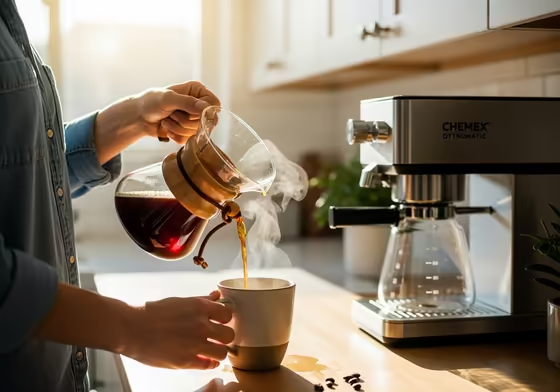
The Chemex Ottomatic delivers on its promise to automate the Chemex brewing process in a beautiful package. But it comes with three major trade-offs. It has a high price, no official SCA certification, and plastic parts that touch hot water.